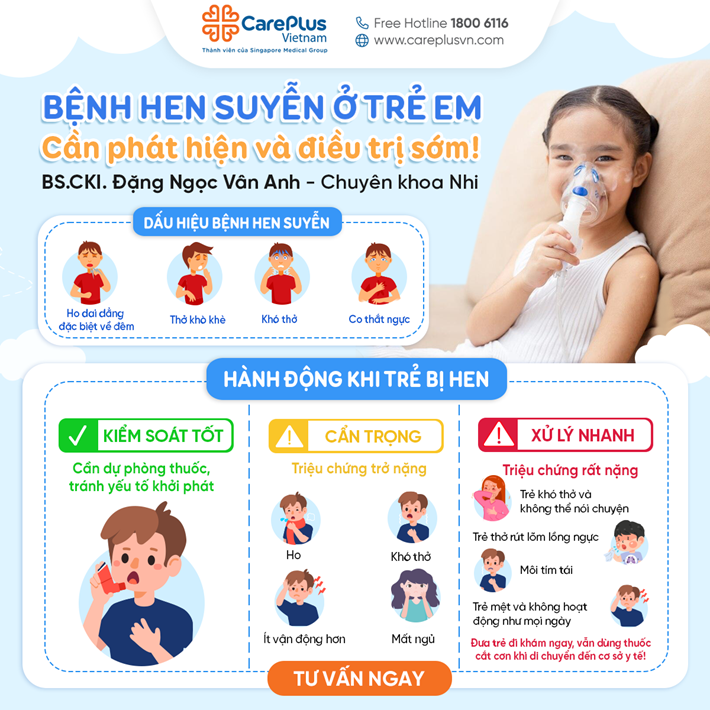ASTHMA IN CHILDREN – Early Detection and Treatment is Key!
Asthma symptoms include wheezing, coughing, chest tightness, and difficulty breathing. These symptoms can come and go, varying with the extent of airway narrowing.

11/6/2024 2:09:08 PM
Asthma is a common respiratory condition that affects millions worldwide.
According to UpToDate 2024, around 6.5% of children under 18 have asthma, and it is more common in boys than girls under age 15. This condition is marked by airway narrowing in the lungs.
Symptoms:
Asthma symptoms include wheezing, coughing, chest tightness, and difficulty breathing. These symptoms can come and go, varying with the extent of airway narrowing.
Triggers and Risk Factors:
-
Upper respiratory infections: Viral infections (e.g., colds) are the most common asthma triggers in infants and young children, with rhinovirus, RSV (Respiratory Syncytial Virus), and influenza being prevalent culprits.
-
Environmental factors: Cold air, changes in atmospheric pressure, rain, or wind can worsen asthma. Air pollution, including smoke and particulates, can also trigger symptoms.
-
Tobacco smoke exposure: Exposure during pregnancy and childhood increases asthma risk.
-
Family history: Children with a personal or family history of asthma, allergies, or eczema have higher risks.
-
Stress: Major life stressors can increase the risk of asthma attacks in children.
-
Physical activity: Exercise can trigger asthma, although short bursts are often tolerated better than prolonged exercise. With proper treatment, children with asthma can still participate in sports at any level.
Recognizing Asthma Symptoms:
Typical asthma symptoms in children include dry coughing and wheezing, particularly noticeable at night or early in the morning. Cold air or physical activity can also trigger these symptoms. Wheezing often sounds like a whistling noise, usually heard during exhalation and sometimes only detectable with a stethoscope.
Asthma symptoms usually develop before age 5, but diagnosing it in infants can be tricky. One-third of children under age 3 may wheeze with colds, but not all will develop asthma. Diagnosis is often clearer when recurring symptoms continue after age 3 and respond to bronchodilators or specialized tests.
Diagnosis and Management:
A proper asthma diagnosis involves evaluating the child's medical and family history, and sometimes, specialized tests to confirm asthma and rule out other causes.
Lung function tests: These measure airflow after a deep breath. If airflow is blocked, the test may be repeated after the use of a bronchodilator to check for reversible obstruction (a hallmark of asthma).
Treatment: Asthma management involves:
-
Identifying and avoiding triggers
-
Regular check-ups every 1-3 months to monitor symptoms and lung function
-
Knowing when and how to use quick-relief medication
Asthma Action Plan:
-
Green Zone: Lungs are functioning well. No symptoms; the child can sleep well and play sports. Continue preventive medication if prescribed and avoid triggers.
-
Yellow Zone: "Caution" – Symptoms like coughing, wheezing, or breathlessness appear. Use a quick-relief inhaler or nebulizer and continue daily medication. Visit the doctor if symptoms don’t improve.
-
Red Zone: "Emergency" – Severe symptoms persist after quick-relief medication. The child struggles to speak, shows chest retractions, or has bluish lips. Seek immediate medical care while continuing quick-relief treatment.
Emergency Symptoms:
-
Severe breathlessness, inability to speak
-
Chest retractions (skin pulling in around ribs)
-
Bluish or pale lips
-
Fatigue and reduced activity
With proper care and understanding, parents can effectively manage asthma, allowing their child to thrive and confidently engage in everyday activities.